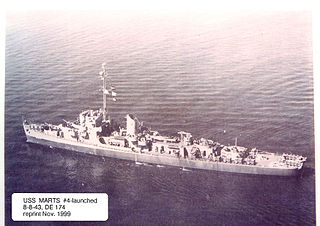
USS Goldsborough (DD-188/AVP-18/AVD-5/APD-32) was a Clemson-class destroyer in the United States Navy during World War II. She was the second Navy ship named for Rear Admiral Louis M. Goldsborough (1805–1877). Entering service in 1920, the ship had a brief active life before being placed in reserve in 1922. Goldsborough was reactivated for World War II and was used as an aircraft tender, destroyer and high speed transport in both Atlantic and Pacific theaters. Following the war, the ship was sold for scrapping in 1946.

USS Goff (DD-247) was a United States Navy Clemson-class destroyer in commission from 1921 to 1931 and from 1932 to 1945. She saw service during the Second Nicaraguan Campaign and World War II. She was named for Secretary of the Navy Nathan Goff, Jr.

USS Guest (DD-472), a Fletcher-class destroyer, was a ship of the United States Navy named for Commodore John Guest (1822–1879).

USS Kearny (DD-432), a Gleaves-class destroyer, was a United States Navy warship during World War II. She was noted for being torpedoed by a German U-boat in October 1941, before the U.S. had entered the war. She survived that attack, and later served in North Africa and the Mediterranean.

USS Eberle (DD-430) was a Gleaves-class destroyer of the United States Navy. The ship is named for Rear Admiral Edward Walter Eberle, who commanded the Atlantic and Pacific Fleets and was Chief of Naval Operations from 1923 to 1927. The destroyer entered service in 1940 and spent the majority of her career in the Atlantic Ocean. Placed in reserve following the war, the ship was transferred to the Hellenic Navy in 1951. Renamed Niki, the destroyer remained in service until 1972 when she was scrapped.

USS Cronin (DE/DEC-704) was a Buckley-class destroyer escort in service with the United States Navy from 1944 to 1946 and from 1951 to 1953. She was sunk as a target in 1971.

USS Halloran (DE-305) was a Evarts-class destroyer escort of the United States Navy.

USS O'Toole (DE-527) was an Evarts-class destroyer escort of the United States Navy during World War II. She served in the North Atlantic ocean protecting convoys and other ships from German U-boats and aircraft. She also performed escort and anti-submarine operations before returning home at the end of the conflict.

USS Alger (DE-101) was a Cannon-class destroyer escort built for the U.S. Navy during World War II. She served in the Battle of the Atlantic and provided escort service against submarine and air attack for Navy vessels and convoys. Alger was named for Philip Rounsevile Alger.

USS Marts (DE-174) was a Cannon-class destroyer escort built for the United States Navy. She served in the Atlantic Ocean in 1943-45 before being transferred to the Brazilian Navy. Renamed Bocaina (D-22), she was in service until 1975, when she was struck and scrapped.

USS Pennewill (DE-175) was a Cannon-class destroyer escort built for the United States Navy during World War II. She served in the Atlantic Ocean and provided escort service against submarine and air attack for Navy vessels and convoys.

USS Reybold (DE-177) was a Cannon-class destroyer escort built for the United States Navy during World War II. She served in the Atlantic Ocean and provided escort service against submarine and air attack for Navy vessels and convoys.

USS Herzog (DE-178) was a Cannon-class destroyer escort in service with the United States Navy from 1943 to 1944. She was transferred to Brazil on 1 August 1944 and served as Beberibe (D-19) until 1966. She was scrapped in 1968.

USS Trumpeter (DE-180) was a Cannon-class destroyer escort in service with the United States Navy from 1943 to 1947. She was sold for scrap in 1974.

USS Straub (DE-181) was a Cannon-class destroyer escort in service with the United States Navy from 1943 to 1947. She was sold for scrap in 1974.

USS Gustafson (DE-182) was a Cannon-class destroyer escort in service with the United States Navy from 1943 to 1946. In 1950, she was transferred to the Royal Netherlands Navy where she served as Hr.Ms. Van Ewijck (F808) until 1967. She was scrapped in 1968.

USS Jubilant (AM-255) was an Admirable-class minesweeper built for the United States Navy during World War II. She served in the Atlantic during World War II. She was decommissioned in May 1946 and placed in reserve. Although she did not see service in the war zone, Jubilant was recommissioned in May 1951 during the Korean War and remained in commission until April 1954, when she was placed in reserve again. While she remained in reserve, Jubilant was reclassified as MSF-255 in February 1955 but never reactivated. In October 1962, she was sold to the Mexican Navy and renamed ARM DM-01. In 1994 she was renamed ARM General Miguel Negrete (C50). She was stricken in 2000, and sunk as an artificial reef off Veracruz in August 2001.
USS Knave (AM-256) was an Admirable-class minesweeper built for the United States Navy during World War II. She served in the Atlantic during World War II and was decommissioned in May 1946 and placed in reserve. While she remained in reserve, Knave was reclassified as MSF-256 in February 1955 but never reactivated. In October 1962, she was sold to the Mexican Navy and renamed ARM DM-13. In 1994, she was renamed ARM Cadete Juan Escutia (C56). She was stricken in 2000, but her ultimate fate is not reported in secondary sources.
USS Lance (AM-257) was an Admirable-class minesweeper built for the U.S. Navy during World War II. She was built to clear minefields in offshore waters, and served the Navy in the Atlantic Ocean.

USS Matagorda (AVP-22/AG-122) was a United States Navy Barnegat-class seaplane tender in commission from 1941 to 1946 that saw service in World War II. After the war, she was in commission in the United States Coast Guard as the cutter USCGC Matagorda (WAVP-373), later WHEC-373, from 1949 to 1967.



















